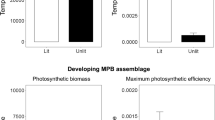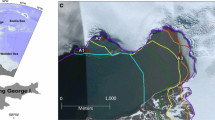Abstract
The vertical zonation of the Antarctic cryptoendolithic community appears to form in response to the light regime in the habitat. However, because of the structure of the habitat, the light regime is difficult to study directly. Therefore, a mathematical model of the light regime was constructed, which was used to estimate the total photon flux in different zones of the community. Maximum fluxes range from about 150μm photons m−2 s−1 at the upper boundary of the community to about 0.1μm photons m−2 s−1. Estimates of the annual productivity in the community indicate that the lowest zone of the community is light limited, with the maximal annual carbon uptake equivalent to less than the carbon content of one algal (Hemichloris) cell.
Similar content being viewed by others
References
Bannister TT (1974) Production equations in terms of chlorophyll concentrations, quantum yield, and the upper limit to production. Limnol Oceanogr 19:1–12
Barkstrom BR, Querfeld CW (1975) Concerning the effect of anisotropic scattering and finite depth on the distribution of solar radiation in snow. J Glaciol 14:107–124
Bell RA, Athey PV, Sommerfeld MR (1986) Cryptoendolithic algal communities of the Colorado Plateau. J Phycol 22:429–435
Bohren CF, Barkstrom BR (1974) Theory of the optical properties of snow. J Geophys Res 79:4527–4535
Chandrasekhar S (1960) Radiative transfer. Dover Publications, Inc, New York
Colijn J (1982) Light absorption in the waters of the Ems-Dollard estuary and its consequences for the growth of phytoplankton and microphytobenthos. Netherlands J Sea Res 15:196–216
Davies-Colley RJ, Pridmore RD, Hewitt JE (1986) Optical properties of some freshwater phytoplanktonic algae. Hydrobiologia 133:165–178
Emslie AG, Aronson JR (1973) Spectral reflectance and emittance of particulate materials. 1. Theory. Appl Optics 12:2563–2572
Fehér D, Frank M (1936) Untersuchungen über die Lichtökologie der Bodenalgen. Arch Mikrobiol 7:1–31
Fenchel T, Staarup BJ (1971) Vertical distribution of photosynthetic pigments and the penetration of light in marine sediments. Oikos 22:172–182
Friedmann EI (1971) Light and scanning electron microscopy of the endolithic desert algal habitat. Phycologia 10:411–428
Friedmann EI (1977) Microorganisms in Antarctic desert rocks from Dufek Massif. Antarct J US 12:26–30
Friedmann EI (1982) Endolithic microorganisms in the Antarctic cold desert. Science 215:1045–1053
Friedmann EI, Galun M (1974) Desert algae, lichens, and fungi. In: Brown GW (ed) Desert biology, vol II. Academic Press, New York, pp 166–212
Friedmann EI, Ocampo R (1976) Endolithic blue-green algae in the dry valleys: primary producers in the Antarctic desert ecosystem. Science 193:1247–1249
Friedmann EI, Ocampo-Friedmann R (1984) Endolithic microorganisms in extreme dry environments: analysis of a lithobiontic microbial habitat. In: Klug MJ, Reddy CA (ed) Current perspectives in microbial ecology. American Society for Microbiology, Washington, DC, pp 177–185
Friedmann EI, Weed R (1987) Trace-fossil formation in modern microbial communities: biogenous and abiotic weathering in the Antarctic cold desert. Science 236:703–705
Friedmann EI, McKay CP, Nienow JA (1987) The cryptoendolithic microbial environment in the Ross desert of Antarctica: satellite-mediated continuous nanoclimate data, 1984 to 1986. Polar Biol 7:273–287
Friedmann I, Lipkin Y, Ocampus-Paus R (1967) Desert algae of the Negev (Israel). Phycologia 6:185–200
Fukshansky L, Kazarinova N (1980) Extension of the Kubelka-Munk theory of light propagation in intensely scattering materials to fluorescent media. J Optical Soc America 70:1101–1111
Goedecke GH (1977) Radiative transfer in closely packed media. J Optical Soc America 67:1339–1348
Goldberg S (1958) Introduction to difference equations. John Wiley and Sons, Inc, New York
Haardt H, Nielsen GA (1980) Attenuation coefficients of monochromatic light in marine sediments. Oceanol Acta 3:333–338
Halldal P (1968) Photosynthetic capacities and photosynthetic action spectra of endozoic algae of the massive coralFavia. Biol Bull 134:411–424
Harris GP (1978) Photosynthesis, productivity and growth: the physiological ecology of phytoplankton. Ergeb Limnol 10:1–171
Hoffmann C (1949) Über die durchlässigkeit dünner sandschichten für Licht. Planta 37:48–56
Hunt GR, Ashley RP (1979) Spectra of altered rocks in the visible and near infrared. Econ Geol 74:1613–1629
Jørgensen BB, Des Marais DJ (1986) A simple fiber-optic microprobe for high resolution light measurements: application in marine sediments. Limnol Oceanogr 31:1376–1383
Kappen L (1983) Ecology and physiology of the Antarctic fruticose lichenUsnea sulphurea (Koenig) Th. Fries. Polar Biol 1:249–225
Kappen L, Friedmann EI (1983) Ecophysiology of lichens in the dry valleys of southern Victoria Land, Antarctica. II. CO2 gas exchange in endolithic lichens. Polar Biol 1:227–232
Kirk JTO (1975) A theoretical analysis of the contribution of algal cells to the attenuation of light within natural waters. II. Spherical cells. New Phytol 75:21–36
Krumbein WE (1979) Photolithotrophic and chemoorganotrophic activity of bacteria and algae as related to beachrock formation and degradation (Gulf of Aqaba, Sinai). Geomicrobiol J 1:139–203
Leclerc JC, Couté A, Dupuy P (1983) Etude des conditions climatiques annuelles de deux stations d'algues subaeriennes sciaphiles. Phycologia 22:445–452
Liou K-M (1980) An introduction to atmospheric radiation. Academic Press, New York
Meador WE, Weaver WR (1980) Two-stream approximation of radiative transfer in planetary atmospheres: a unified description of existing methods and a new improvement. J Atmospheric Sciences 37:630–643
Melamed NT (1963) Optical properties of powders. Part I. Optical absorption coefficients and the absolute value of the diffuse reflectance. Part II. Properties of luminescent powders. J Appl Physics 34:560–570
Nicot J (1960) Some characteristics of the microflora in desert sands. In: Parkinson D, Ward JS (ed) The ecology of soil fungi. University of Liverpool Press, Liverpool, pp 94–97
Nienow JA, McKay CP, Friedmann EI (1988) The cryptoendolithic microbial environment in the Ross desert of Antarctica: mathematical models of the thermal regime. Microb Ecol 16:253–270
Perkins EJ (1963) Penetration of light into littoral soils. J Ecol 51:687–692
Pollack JB, McKay CP (1985) The impact of polar stratospheric clouds on the heating rates of the winter polar stratosphere. J Atmospheric Sciences 42:245–262
Priddle J (1980) The production ecology of benthic plants in some Antarctic lakes. II. Laboratory physiology studies. J Ecol 68:141–153
Reuter R (1980) Characterization of marine particle suspensions by light scattering. I. Numerical predictions from Mie theory. Oceanol Acta 3:317–324
Sagan C, Pollack JB (1974) Differential transmission of sunlight on Mars: biological implications. Icarus 21:490–495
Seyfried M, Fukshansky L (1983) Light gradients in plant tissue. Appl Optics 22:1402–1407
Simmons EL (1975) Diffuse reflectance spectroscopy: a comparison of the theories. Appl Optics 14:1380–1386
Spurr SH, Barnes BV (1973) Forest ecology. Ronald Press Co, New York
Tschermak-Woess E, Friedmann EI (1984)Hemichloris antarctica, gen. et sp. nov. (Chlorococcales, Chlorophyta), a cryptoendolithic alga from Antarctica. Phycologia 23:443–454
Valiela I (1984) Marine ecological processes. Springer-Verlag, New York
van de Hulst HC (1980) Multiple light scattering, vol 1 and 2. Academic Press, New York
Vestal JR, Federle TW, Friedmann EI (1984) The effects of light and temperature on the Antarctic cryptoendolithic microbiotain vitro. Antarct J US 19:173–174
Vogelmann TC, Bjorn LO (1984) Measurement of light gradients and spectral regime in plant tissue with a fiber optic probe. Physiol Plant 60:361–368
Weast RC (ed) (1976) Handbook of chemistry and physics. 57th ed. CRC Press, Cleveland, p F-200
Williams TP (1985) Some uses of a MacNichol-type microspectrophotometer in the study of retinal photoreceptors. In: Fein A, Szuts E (ed) The visual system. Allan R Liss, Inc, New York
Author information
Authors and Affiliations
Rights and permissions
About this article
Cite this article
Nienow, J.A., McKay, C.P. & Friedmann, E.I. The cryptoendolithic microbial environment in the Ross Desert of Antarctica: Light in the photosynthetically active region. Microb Ecol 16, 271–289 (1988). https://doi.org/10.1007/BF02011700
Issue Date:
DOI: https://doi.org/10.1007/BF02011700




